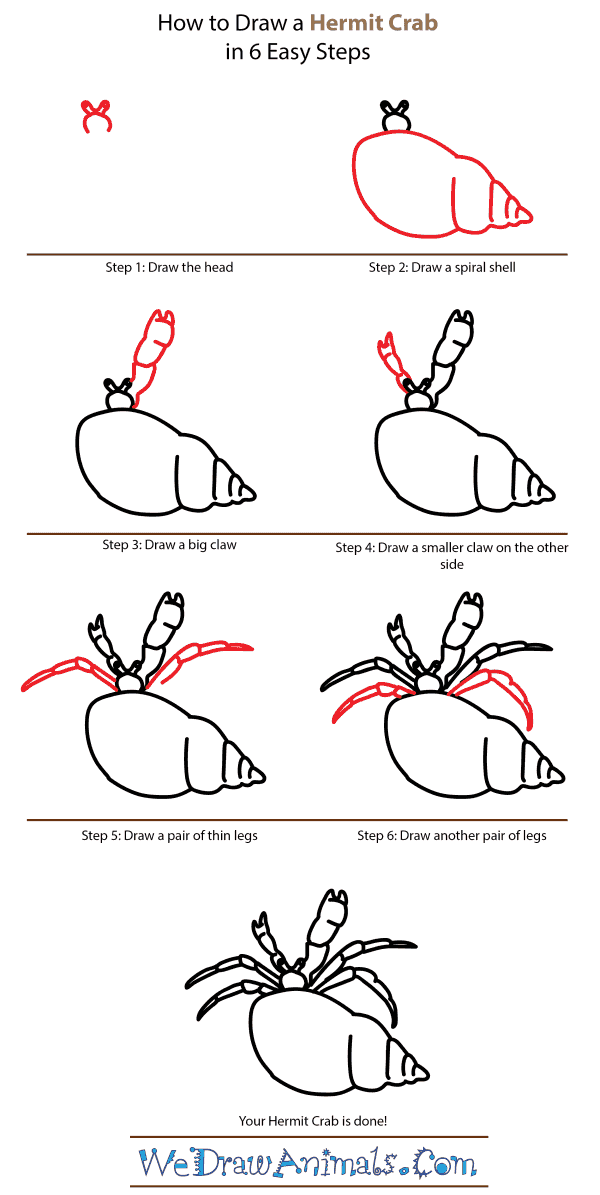In this quick tutorial you'll learn how to draw a Hermit Crab in 6 easy steps - great for kids and novice artists.
The images above represent how your finished drawing is going to look and the steps involved.
Below are the individual steps - you can click on each one for a High Resolution printable PDF version.
At the bottom you can read some interesting facts about the Hermit Crab.
Make sure you also check out any of the hundreds of drawing tutorials grouped by category.
How to Draw a Hermit Crab - Step-by-Step Tutorial
Step 1: Draw a circle with two small ovals on top for the head
Step 2: Draw a spiral seashell (it can have lots of spirals if desired)
Step 3: From the right side of the head, draw a large claw pointing upward
Step 4: Repeat with the left side of the head, only make it smaller
Step 5: Draw another pair of legs underneath them
Step 6: Draw the final pair of legs beneath the second set, only smaller
Interesting Facts about the Hermit Crab
This hugely varied species of crab consists of 1,100 different sub-species, both water-dwelling and terrestrial. They are most commonly noted for their shell, which is usually scavenged from other animals and covers their entire torso. Though the torso is not usually seen except for when the hermit crab is changing shells, it has been observed as being long and asymmetrical and resembling a spiral in shape. They can retract their entire body, head and all, into the interior of their shell, which is usually found shells of sea snails, or even hollow pieces of stone or wood. They use their curved tails to hold the shell in place on their backs, as to avoid losing it while they navigate their habitat. There is no consistent size of this species, as they all vary quite a bit in length and height. The largest land invertebrate in the world is the shell-less hermit crab, known as the coconut crab. Despite this species’ name, the hermit crab actually bares fewer resemblances to the common crab than it does with lobsters. The hermit crab requires larger shells as they grow, forcing them to find new shells every now and then to accommodate their growing size. Since intact shells can be difficult to find, they will often have to compete with other hermit crabs for them. If they cannot find a suitably sized shell to change into, the hermit crab’s growth will be noticeably stunted by its small, ill-fitting shell.
Did you know?
- Hermit crabs that are in too-small shells are more likely to be eaten by predators, since they cannot pull their body into their shell.
- Numerous hermit crabs will form what is called a “vacancy chain” to exchange shells with one another. If a potential new shell is too big for a hermit crab to inhabit, it will remain near this shell and await the arrival of other hermit crabs. They will stand here for up to eight hours, and in that time numerous other hermit crabs will come upon the same shell. They will all wait in a line, from largest to smallest, until the right sized crab comes along to take the new shell. Then, they will exchange their shells in a line so that each hermit crab gets a one-size upgrade.
- Since competition for higher-quality shells is quite common, hermit crabs have been seen fighting each other, prying away new shells away from one another for their own intended use.
- Some marine species of the hermit crab will carry two or more sea anemones on their shells. This is a mutually beneficial arrangement, as the sea anemones will scare away predators and get to eat remains of the hermit crab’s meals.
- There are two different types of hermit crabs: marine and terrestrial (land-dwelling). The marine species of hermit crab is very popular in aquariums, and can also breathe on land as long as their gills remain moist. Some marine hermit crabs do not use shells, but rather seek shelter in other, immobile structures left by coral, sponges and other sea life. The land hermit crab lives in tropical areas and mostly on dry land, though they do require a combination of fresh and salt water to keep their gills wet and to reproduce. There are about fifteen species of land hermit crabs, and there is only one freshwater-dwelling species of marine hermit crab.
Arts and Crafts Activity Notes: : Draw the hermit crab’s spiral body, head and limbs and make enough copies for each participant to have one. Instruct them to color their crab with crayons, colored pencils or markers, and then carefully cut them out with safety scissors. Once this is done, set aside the hermit crab design for now, and have each participant fashion their own shell for their drawn crab. This can be done with pages from magazines, repurposed fabric such as felt or old cloth rags, and anything else that you can think of that can be easily glued or taped to the back of the crab. Instruct each participant to glue their pieces of material together in whatever form they’d like, creating their own custom shell, and once the glue has dried, have them fix it with tape or glue to the back of their crab. Once everyone has finished this task, arrange the hermit crabs on a wall or board in order from smallest to largest shell, to create your own vacancy chain!







